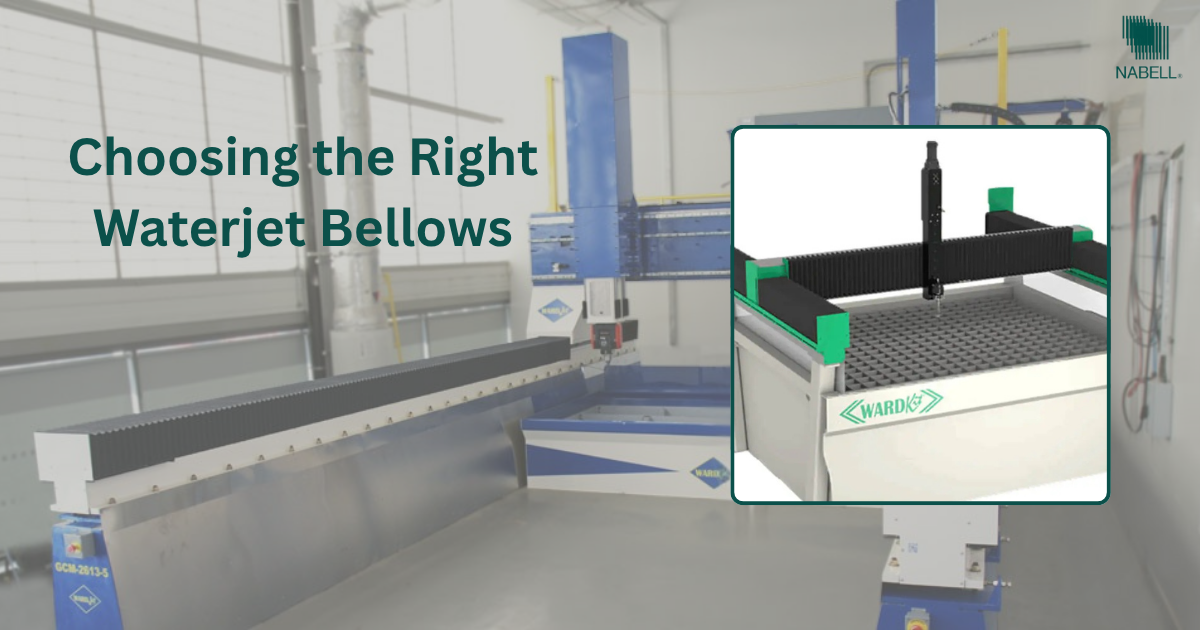Waterjet cutting bellows are durable protective covers designed to shield vital machine components such as guideways, screws, and linear rails from abrasive spray, high-pressure fluids, and debris during waterjet cutting. These bellows offer protection to the waterjet cutting equipment, thus helping maintain precision, minimize downtime, and prolong equipment lifespan. By forming a sealed barrier, they prevent contamination and mechanical failure, enhancing machine efficiency and accuracy. With various materials and configurations offered by waterjet cutting bellows manufacturers, selecting the appropriate bellows is crucial. This post delves into key parameters of waterjet cutting bellows to protect machinery, choosing the right bellows, and maintenance tips to ensure long-term efficiency and reliability.
Choosing the Right Waterjet Cutting Bellows
Selecting the right waterjet cutting bellows is crucial to ensuring your waterjet machinery performs at its peak without compromising on protection or efficiency. It is essential to understand the core specifications that influence performance, durability, and compatibility with your equipment. These parameters help ensure that the bellows can withstand your specific operating environment. Here are some pointers that may help you choose the right one based on your requirement.
- Material Compatibility and Chemical Resistance: The bellows material must be resistant to high-pressure water flow, abrasive chemicals commonly used in waterjet applications. Materials such as polyurethane-coated fabrics or reinforced Kevlar blends are often preferred by waterjet cutting bellows manufacturers for their high durability and chemical resistance.
- Motion and Compression Range: Bellows must accommodate the full range of motion of machine axes without binding or compressing excessively. The bellows should allow smooth movement and proper expansion and contraction, especially in multi-axis CNC systems where dynamic movement is constant.
- Seal Integrity and Environmental Protection: Bellows must offer tight sealing to prevent ingress of water, dust, and abrasive particles. Seal integrity is essential to prevent contamination of internal machinery and support the longevity of your flow waterjet bellows system.
- Mounting and Configuration Flexibility: Custom-fit designs that align with machine specifications, including flange types, mounting orientation (vertical or horizontal), and frame shape, are critical for ensuring proper installation and optimal protection performance. Many waterjet bellows manufacturers in the USA provide custom designs for unique setups.
- Operating Environment Compatibility: One of the foremost considerations when choosing bellows is the type of environment in which they will function. Factors such as humidity, temperature, and exposure to abrasive materials should dictate the kind of protection needed. Bellows that are engineered for wet and gritty environments, such as those from flow waterjet bellows lines, offer robust performance in high-demand settings.
- Durability and Load Endurance: The bellows must be capable of withstanding repeated cycles of expansion and compression while supporting operational loads. High-performance waterjet cutting bellows manufacturers often test their products to endure thousands of motion cycles without degradation, ensuring extended service life.
- Design Customization: Standard bellows might not fit all machinery perfectly. Choosing manufacturers that offer custom designs ensures that the bellows match the exact specifications of your waterjet cutting system, reducing installation issues and improving performance.
Maintenance Tips for Waterjet Cutting Bellows
Even the highest-quality bellows require regular maintenance to maintain their protective capabilities. Proactive care not only extends the life of the bellows but also safeguards the machinery, ensuring consistent and reliable performance across operational cycles.
- Regular Cleaning and Inspection: Accumulated debris, abrasive residues, or moisture can degrade bellows material over time. It is essential to clean the bellows regularly with mild detergents and inspect for early signs of wear or punctures. Routine inspections can prevent small issues from escalating into expensive repairs.
- Monitor for Signs of Fatigue or Cracking: Continuous flexing and exposure to harsh elements may eventually cause material fatigue or cracking. Keep an eye on seams, folds, and corners, which are most susceptible to wear and tear. Replace damaged bellows promptly to avoid compromising internal machine parts.
- Proper Lubrication of Adjacent Components: Ensure that the moving parts adjacent to the bellows are well-lubricated and free from burrs or sharp edges. These mechanical elements should operate smoothly to prevent unnecessary strain or tearing of the bellows fabric.
- Secure Mounting Checks: Over time, mounting hardware can loosen due to vibrations or mechanical movement. Make sure that bellows are firmly and securely mounted. Any play or looseness can allow contaminants to infiltrate protected zones.
- Keep Spare Bellows in Inventory: Downtime can be minimized by having spare bellows readily available. Coordinate with waterjet bellows manufacturers for consistent stock replenishment and quick replacements.
Protect Your Precision – Choose the Right Bellows Today!
Nabell, as a renowned waterjet bellows manufacturer in the USA, offers bellows specifically engineered for waterjet machines. We provide various shapes and styles, including thermal welded, perforated fold, combination fold, and sewn shape bellows. With material options from aluminized Kevlar to PVC coated Polyester, we tailor solutions to meet your exact needs. For further details or custom requirements, contact our sales team today and get the perfect protection for your machinery.

